Adding Parts and Other Costs to a Serialized Item
EBMS allows the user to add parts, labor, or other costs to individual
serialized items. For example, a serialized item that is purchased from
a vendor or is a trade-in may need an additional part before the item
is sold. The cost of the part(s) must be reduced from inventory and added
to the cost of the serialized item. The total cost of inventory (parts
or other perpetual items), labor, and other costs are recorded within
the individual items to manage the serialized item.
Costs can be added to a serialized item using any of the following methods:
Add inventory products from stock
Add non-inventory parts or labor that increases the value
of the serialized item
Add costs from a purchase order
Add parts and labor from a task or work order
Adding Costs
Complete the following steps to add costs using any of these methods:
Open a serialized item record and click on the Costs tab as shown below:
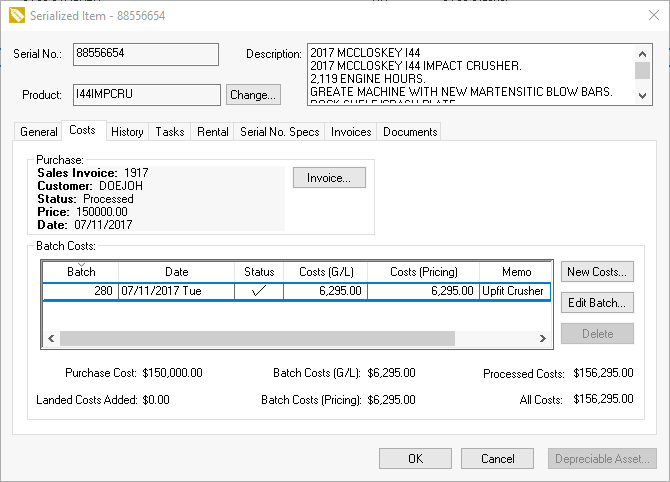
The Costs tab displays the following costs for the
serialized item:
Purchase Cost:
This is the purchase
cost of the serialized item derived from the expense
invoice if the item was purchased or the manufactured value if
the item was manufactured. The Vendor
will display ($)ADJUST
if the item was manually added or ($)MFG
if the item was manufactured.
Landed Cost: This
cost is added to the purchase cost to give a total cost including
shipping or other process cost. Review [Financials]
Landed Costs > Overview for more details on this advanced
purchase cost feature.
The Cost (G/L)
value will be zero if the Only
post Track Count Inventory Values to G/L option is enabled
and the inventory item is not classified as Track
Count or other perpetual item.
The Cost (Pricing)
amount will be copied from the perpetual cost of the inventory
item and cannot be changed if the inventory item is classified
as Track Count. The cost
can be edited if the item is classified as No
Count or Service. Review
Only
Post Track Count Inventory Values to GL for details on the
Cost (G/L) amount.
The Processed Costs total reflects
the total costs that are processed through added cost batches.
The All Costs total reflect all
costs even if they the costs have not been processed by clicking
on the Process button of the added
cost batch.
Additional costs are added to an item in batches.
Click on the New Costs
button to create a new batch of costs.
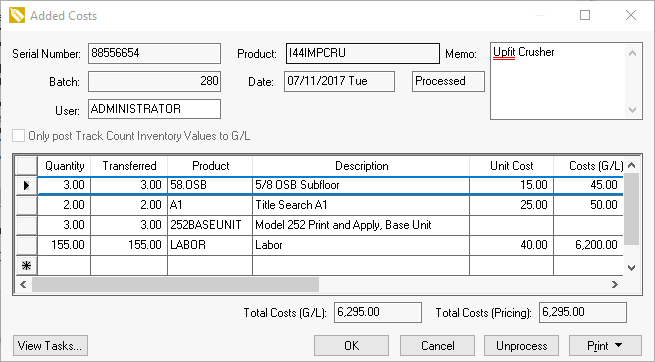
The Batch number is automatically
incremented unless the user manually enters a batch number. The Batch
number can be set within .
Enter the Date
the batch of costs is added to the inventory item.
Verify the User name.
The User defaults to
the login user. This value can be set to identify the individual responsible
for posting the costs to the item.
Disable the Only post Track
Count Inventory Values to G/L option. Review Only
Post Track Count Inventory Values to GL for details on this option.
Enter miscellaneous information within the Memo
field.
Enter cost details.
Enter the quantity of items added in both the Quantity
and Transferred columns. The
only advantage of entering a Quantity
amount and not entering a Transferred
amount is if you wish to allocate some inventory but the inventory
has not been added at the time of the entry. The Quantity and Transferred
fields are processed in a similar way as the Ordered and Shipped fields
within the sales invoice. The quantity affects the Net Ordered amount
with in the inventory item's count tab but it is not subtracted from
the total inventory On-Hand.
Enter the Inventory
item and unit of Measure setting.
The Description will be populated
from the inventory record.
Repeat the steps listed above for each inventory item that you wish
to add to the registered whole goods.
Click on the OK button to save
the batch of costs without processing the batch. The batch must be processed
by clicking on the Process button
to apply costs to serialized item.
The Task
and Work Order module within EBMS can be used to apply the costs to
a serialized item: This option is useful when processing a worker
order for equipment or vehicles that are being resold. Review [Labor]
Tasks > Creating Tasks > Linking Tasks to a Serialized Item
for instructions on this powerful tool for trade-in equipment, up-fitters,
or other serialized items that are sold after the work order is processed.
Added Costs Report
The recommended method to list the Added Cost Batch details is to generate
a report. Complete the following steps to generate the added cost
information:
Open a serialized item, click on the Costs
tab, and open the Added Costs dialog as shown below:
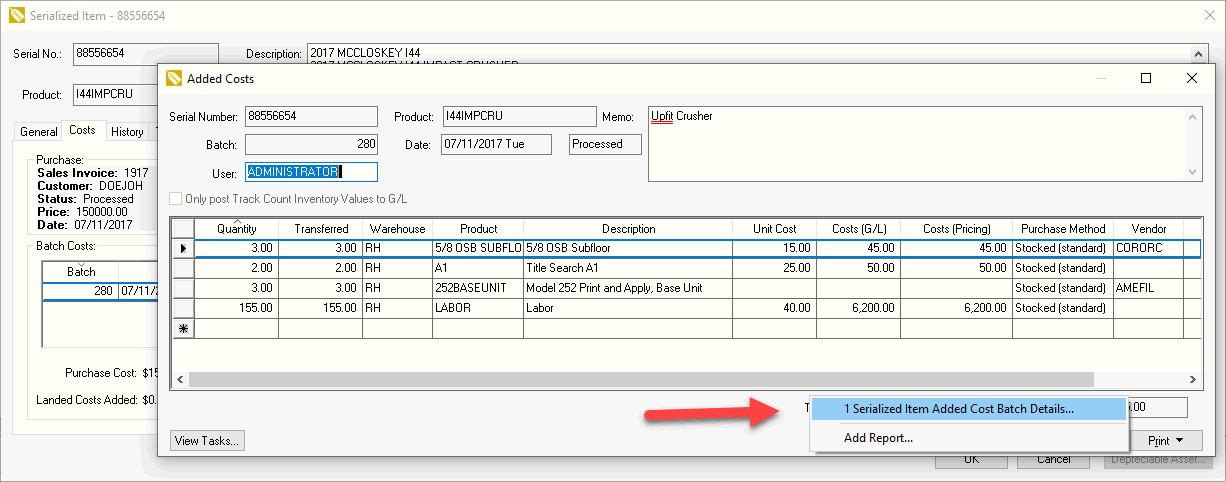
Launch the Serialized Item Added Cost
Batch Details report from the Print
button as shown above. Many of the prompts shown below will
default when launched from the Print button.
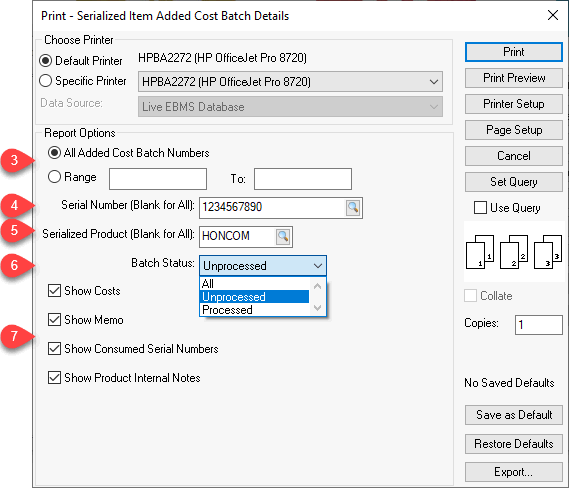
This report can also be launched by selecting from the main
menu.
Select a Range of Added Cost Batch Numbers
or select a single batch by launching the report from the batch's
print button. Review [Main]
Reports > Print Buttons and Menus for instructions to a print
button.
Enter an optional Serial Number:
Leave this entry blank to list all added cost batches rather
than limiting the list to a single serial number.
Enter a Serialized Product to limit
the list to a group of serial numbers with the selected inventory
ID. Keep this setting blank to list all items.
Select the Batch Status of All, Unprocessed batches, or Processed
batches.
Set other optional report settings and click Print Preview to
generate the following report:
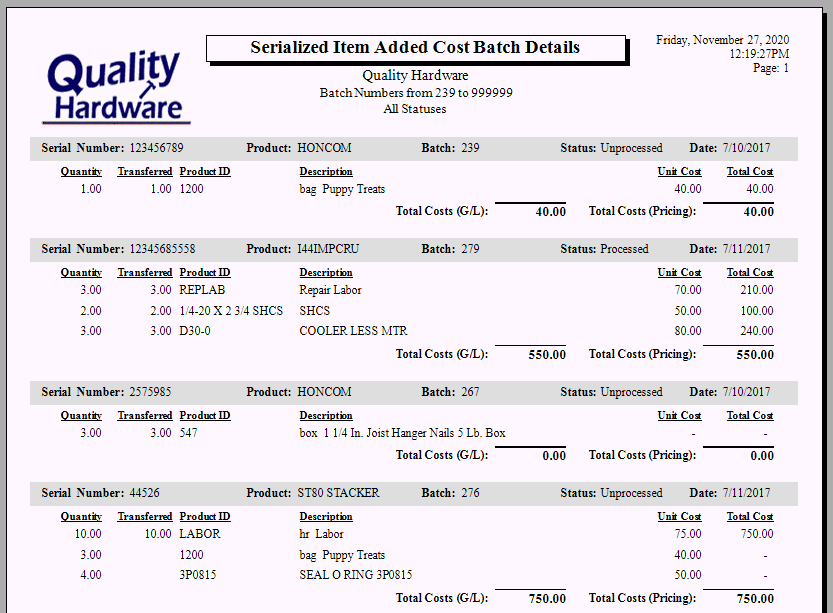
Attaching Costs to a Purchase Order
Complete the following steps to create a purchase order from the Added
Cost batch as shown below:
- Create an added cost batch and enter the information as described
in the steps listed above.
- Enter a special order Product code and
set the appropriate Purchase Method as shown below:

- Enter a detailed description that will be copied to the purchase
order.
- Enter a Vendor ID to identify the purchasing vendor.
- Right click on the line and select Create Order:
Purchase Order as shown below to create the PO.
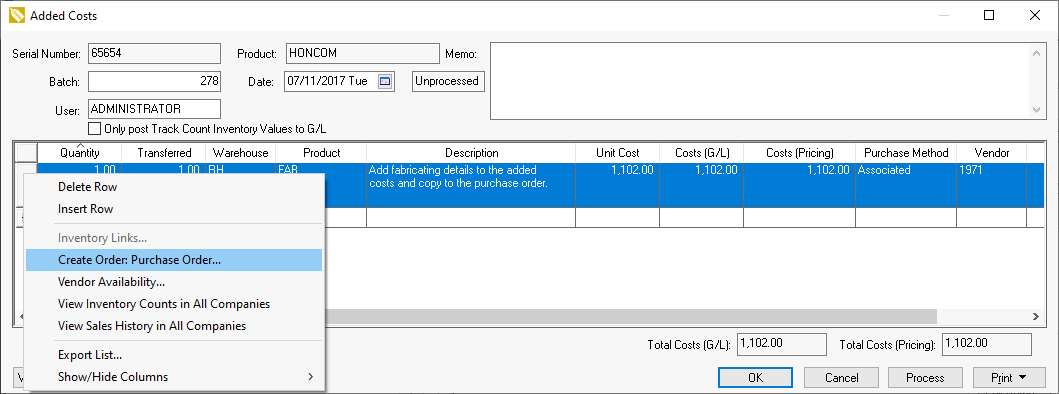
- Create purchase orders for additional lines within the same batch
if desired.
Review Special Orders and Drop
Shipped Items > Purchasing Special Orders for more details on this
powerful special order process that creates purchase orders from Added
Cost Batches, sales orders, and manufacturing batches.
Attach a Task or Work Order to Add Costs
Parts and labor costs can be added to a serialized Item's added cost
batch by attaching a task to a batch. Review [Labor]
Tasks > Creating Tasks > Linking Tasks to a Serialized Item
for instructions to use tasks to create an Added Cost Batch.
Process Transactions
The process procedure creates the following general ledger transactions:
Debit |
Credit |
Amount |
Inventory Asset Account
(Serialized item) |
Inventory Variance
(Serialized item) |
Total Cost (G/L) |
Inventory Variance Account of each detail item |
If the Cost
(G/L) value not zero (Track Count items) then
Inventory Asset Account
If the Cost(G/L)
is zero (No Count Items) then
Manufacturing Offset
general ledger found within the items Advance
tab. |
Cost (Pricing) of
each line |
Unprocess or Void Added Cost Batch
Complete the following steps to unprocess or void a cost batch:
Select a cost batch from the Cost
tab of the serialized item.
Click on the Edit
Batch button to open the cost batch.
Click on the Unprocess
button to reverse the cost transactions.






